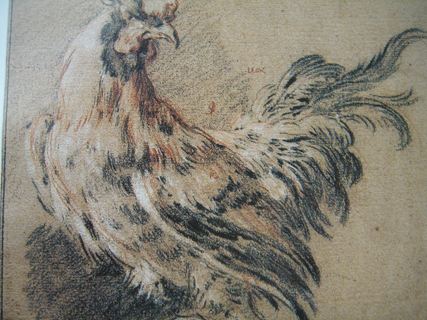In just three days time, on 9 February, the Chinese will be celebrating their new year, the year of the Rooster. For good luck, those celebrating this auspicious event are advised, on the day, to wear something green, prefgerably made from natural fibres, and to eat a simple meal such as might appeal to roosters. Chinese astrologers suggest cooking beans and oats and perhaps even sprinkling the table with some seeds, as well as saying “cock-a-doodle-doo!” several times. They also say that it might please the Rooster, and invoke good fortune, to display an image of one somewhere prominent in the house this year.
So today’s special, cut-out-and-keep work of art is the very best picture of a rooster that I can think of, by the brilliantly gifted French eighteenth-century painter and draughtsman Francois Boucher. It was created in 1727-8 and done in black, red and white chalk – “the three chalks” as French artists of the time called them – on a coarse-woven brownish grey piece of paper. This wonderfully vivid depiction of a proudly strutting bird, patrolling its territory with a haughty and imperious air, is to be found in the cabinet of drawings at the Nationalmuseum of Stockholm.
In a long and prolific career, Boucher created some 10,000 drawings. During the course of his regular 12-hour day, when he was not painting landscapes, portraits and erotic mythologies, designing tapestries and porcelain, creating stage-sets for opera and theatre or immortalising the King’s mistress, Madame de Pompadour, he almost invariably had a pencil in his hand. His contemporary Greuze’s remark about another, equally prolific draughtsman of the time, Gabriel de Saint-Aubin – that “il avait un priapisme du dessin”, he suffered from priapism of the pencil – might with equal truth be applied to Boucher.
According to...

ITP 249: Study of a Cockerel, by Francois Boucher
06-02-2005

